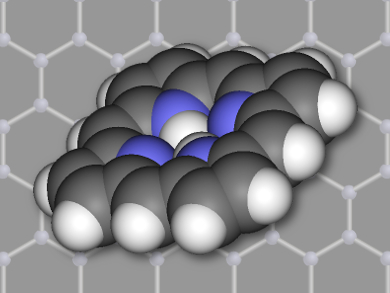Tetrapyrroles such as porphyrins have important functions in biochemistry, for example in hemoglobin or chlorophyll. They also have potential applications in molecular electronics, sensing, catalysis, and light harvesting. Combining such compounds with graphene, which can transport electrical charge, can lead to useful hybrid materials. This coupling can be done in solution, however, such processes lack control over the structure of the resulting material.
Willi Auwärter, Technical University Munich, Garching, Germany, and colleagues have developed a method for the dehydrogenative coupling of single porphines to graphene edges on a metal substrate. The team synthesized graphene on an Ag(111) surface by the deposition of atomic carbon at 900 K. Then they vapor-deposited free-base porphines (the simplest porphyrin, pictured) on the same silver surface at room temperature. Annealing at 620 K caused the porphines to couple to the graphene edges.
The researchers were able to visualize the product using scanning tunneling microscopy (STM) and atomic-force microscopy (AFM). They found binding modes with between one and four C–C bonds between the graphene and the porphine. The porphines retained their ability to form metal complexes. According to the team, this coupling process could be useful for the development of complex materials systems with tunable functionalities.
- Fusing tetrapyrroles to graphene edges by surface-assisted covalent coupling,
Yuanqin He, Manuela Garnica, Felix Bischoff, Jacob Ducke, Marie-Laure Bocquet, Matthias Batzill, Willi Auwärter, Johannes V. Barth,
Nat. Chem.2016.
DOI: 10.1038/nchem.2600




